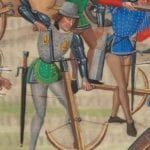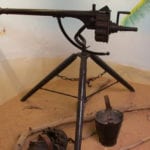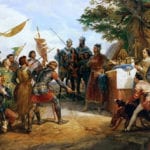 History
History  History
History  Food
Food 10 Weird Foods Inspired by Your Favorite Movies
 Religion
Religion 10 Mind-Blowing Claims and Messages Hidden in the Bible Code
 Facts
Facts 10 Things You Never Knew about the History of Gambling
 Weird Stuff
Weird Stuff 10 Cool and Creepy Facts about Collecting Tears
 Humans
Humans The Ten Most Lethal Gunslingers of the Old West
 Misconceptions
Misconceptions 10 Phony Myths and Urban Legends That Just Won’t Die
 History
History 10 Amazing Roman Epitaphs
 Weird Stuff
Weird Stuff 10 Niche Subcultures That Are More Popular Than You Might Think
 Mysteries
Mysteries 10 Tragic Disappearances and Deaths in Joshua Tree National Park
 History
History Top 10 Tragic Facts about England’s 9 Days Queen
 Food
Food 10 Weird Foods Inspired by Your Favorite Movies
 Religion
Religion 10 Mind-Blowing Claims and Messages Hidden in the Bible Code
Who's Behind Listverse?

Jamie Frater
Head Editor
Jamie founded Listverse due to an insatiable desire to share fascinating, obscure, and bizarre facts. He has been a guest speaker on numerous national radio and television stations and is a five time published author.
More About Us Facts
Facts 10 Things You Never Knew about the History of Gambling
 Weird Stuff
Weird Stuff 10 Cool and Creepy Facts about Collecting Tears
 Humans
Humans The Ten Most Lethal Gunslingers of the Old West
 Misconceptions
Misconceptions 10 Phony Myths and Urban Legends That Just Won’t Die
 History
History 10 Amazing Roman Epitaphs
 Weird Stuff
Weird Stuff 10 Niche Subcultures That Are More Popular Than You Might Think
 Mysteries
Mysteries 10 Tragic Disappearances and Deaths in Joshua Tree National Park
10 Military Underdogs Who Triumphed Against Incredible Odds
Underdogs have a special place in the hearts of many, whether it’s the upstart Celtic Iceni tribe led by Boudicca revolting against the Romans or the ice-veined Spartans fighting in one of history’s greatest last stands against the Persians at Thermopylae. Either through superior tactics or more technologically advanced weaponry, the outnumbered often achieve some form of victory, whether moral or outright. Here are 10 such examples of great historical underdogs.
10British East India Company
Battle Of Assaye

Arthur Wellesley, the major general of the British forces and future first Duke of Wellington, said this of the battle: It was “the bloodiest for the number that I ever saw.” One of the major battles of the Second Anglo-Maratha War, a conflict between the British East India Company and the Maratha Empire, the Battle of Assaye saw between 6,500–10,000 British soldiers face off against a 40,000–50,000 strong Maratha army.
Unfortunately for the British, their intelligence about the strength and location of their enemy was flawed. Not only were they in the wrong location, but they were much stronger than expected, having recently swelled by several divisions. Luckily for Wellesley, he was a better battlefield general than he was a strategist, as he quickly devised a plan to strike quickly, rather than wait for the reinforcements coming along under the command of Colonel Stevenson. (He had divided his army based on the faulty intelligence he had received, and the rest of his forces were miles away.)
However, the main reason for the British victory was the Maratha army simply didn’t believe that Wellesley would attack while being outnumbered so badly. This surprise led to a rout, one in which 5,000–6,500 soldiers of the Maratha army fell in battle. (The British lost about 1,500.) Later in his life, the Duke of Wellington reminisced about his many military triumphs and concluded that his victory at Assaye was the greatest of them all.
9King David IV And The Georgian Army
Battle Of Didgori

Otherwise known as David the Builder for his role as the architect of the Georgian Golden Age, King David IV of Georgia (the country, not the state) was faced with a problem that had plagued his country for years. The Seljuq Turks, Muslims from present-day Kazakhstan, had control over most of the Georgian state. (Various internal wars and earthquakes also helped to weaken the country’s resolve.) Ascending to the throne at the tender age of 16, David IV gathered together the various feudal lords in the area, formed an army, and began repelling the Seljuq occupiers, refusing to pay them any tribute.
Invigorated by the First Crusade’s success against Muslim armies, David IV initiated his plan to take Tbilisi, a great Georgian city and future capital of the country, which had been under Muslim control for nearly 500 years. So around 56,000 men began marching toward the city, camping at Mount Didgori, some 40 milometers (25 mi) from Tbilisi. Though contemporary records exaggerate the amount of forces facing the Georgians, conservative estimates put it at 100,000–250,000 men.
In a similar vein to Stalin and his infamous Order No. 227 (the “Not one step back!” order), David IV declared that retreat was not an option, barricading the route behind his men with trees and boulders. Then, in an act of treachery, he sent 200 heavily armed cavalrymen to the Seljuq leaders under the pretense that they were deserters. When they arrived, the Georgians attacked, killing the leaders and demoralizing the Muslim army. The Battle of Didgori was on, and it only lasted three hours, with the Seljuq Turks taking heavy losses, both as dead and captured, while the Georgians got off relatively light. (Actual casualty counts are hard to come by.) Tbilisi soon fell, and Georgia had its capital once again.
8Mexican Army
Battle Of Puebla

Picture it: Puebla, Mexico, 1862. The liberal Benito Juarez had been elected as president during the prior year, as the country began to fall into financial ruin, thanks to the enormous foreign debt they had accumulated over the years. Britain, France, and Spain each sent their own navies to Veracruz, demanding payment from the Mexican government. Deals were reached with Britain and Spain, who departed shortly afterward, but Napoleon III, nephew of Napoleon Bonaparte, saw an opportunity to establish a Mexican empire and refused to negotiate, landing an invading army instead.
Veracruz was stormed first, quite successfully, and the ease of the fighting convinced the French leaders that victory would come quickly throughout the country. Mexico City, the capital of the country, was the target, but a well-fortified city lay in the direct path the French decided to take: the city of Puebla. 6,000 French troops marched on the city, determined to wrest it from the hands of its ragtag band of 2,000 men. (As any military historian would tell you, a ratio of at least 3:1 is necessary for any sieging army.)
However, even with their superior numbers and artillery, the French were rebuffed in their assault. Starting at daybreak on May 5, the fighting lasted until early evening, with the French suffering five times as many casualties as the Mexicans. (Admittedly, the French only lost 500 people.) It was not strategically important—not only did the French ultimately take over the country for a short period, they even took the city itself a year later. But the victory served as a morale boost for the Mexican army, as well as the people of Mexico, who later created a holiday to celebrate the battle: Cinco de Mayo. (However, it is much more widely celebrated in the United States today than anywhere in Mexico, often under the misnomer of Mexican Independence Day.)
7Croatian National Guard
Battle Of Vukovar

When the president of Yugoslavia, Josip Tito, died in 1980, he left behind a fractured country, one cobbled together from formerly different states. (The six socialist republics were Bosnia and Herzegovina, Croatia, Macedonia, Montenegro, Slovenia, and Serbia.) Serbian nationalists seized the opportunity and tried to centralize control of the country in their capital city of Belgrade. However, most of the other states wanted to break loose, with Croatia being one of them.
On June 25, 1991, the Croatians declared independence, though sporadic fighting between nationalist groups and police had been taking place since the end of March. Two months later, Serbian forces marched on Vukovar with about 36,000 men, determined to take the city, an important regional center on the eastern border of Croatia. Unfortunately for the Croats, the defending force was only 1,800 strong, with some of the Croatian citizens of the city doing what they could to support the troops.
For 86 days, the defenders held off the Serbians, before they finally surrendered, having ran out of ammo. (Reinforcements from other parts of the country never came.) Casualties on both sides were high, with the Serbian forces losing nearly twice as many men; the Croatian defenders lost nearly all of their men to death or injury. The aftermath of the battle was even worse for the inhabitants of the city, as the Serbs butchered 200 Croats who had taken refuge in the city’s hospital and had been promised safe passage out of the city. Widespread executions by Serbian forces were reported throughout the city as well, as ethnic cleansing began to rear its ugly head.
6English Troops
Battle Of Crecy

Though not as well known or devastating to the French as the Battle of Agincourt some 70 years later, the Battle of Crecy was arguably the most important battle in the entirety of the Hundred Years War. Relatively little attention was paid to the English longbow in the country, a weapon widely seen as one of the most devastating weapons in medieval times. That all changed in 1332 under the instruction of Edward III; he realized a large mass of longbows, fired in unison, could defeat much larger armies.
For 14 years, he built up his army of longbowmen, training and equipping them at a much lower cost than the traditional aristocratic knights who had previously made up his army. In July 1346, somewhere around 10,000 men landed on the French coast, outnumbered by nearly three to one. In fact, the French king at the time, Phillip VI, was so confident in his numerical superiority that he made a list of English knights he planned to take prisoner once they had won. Unlike Agincourt, in which the terrain played a large role in determining the outcome of the battle, Crecy was won simply because no one had really seen the longbow in action, and its novelty proved to be the deciding factor.
The French, as well as many other countries, had often looked at archers as defensive troops, with the crossbow seen as the most superior ranged weapon. However, the English longbowmen could fire six to seven times more arrows per minute, contributing to them killing the French crossbowmen very quickly. Any who retreated were cut down by advancing French horsemen, who took it as a sign of cowardice. In the end, confusion and fear (as well as longbowmen) ravaged the French forces, and at least 10,000 of them met their demise. (An argument could be made this isn’t an underdog victory, as the English enjoyed such a strategic advantage, but it shocked all of Christendom nevertheless.)
5Irish UN Troops
Siege Of Jadotville

The year was 1961. Ireland had only been recently admitted to the UN, as the Soviet Union had vetoed them relentlessly due to their neutrality during World War II, and this was their first peacekeeping operation. Though they weren’t exclusively made up of Irish soldiers (there were Swedish and Indian men as well), the UN troops in the state of Katanga in the Congo numbered only 158 and were very lightly armed. Stationed at the wealthy mining town of Jadotville, the troops were ordered to defend the locals from Katangan militia and Belgian mercenaries.
Having dug trenches, the Irish forces used accurate shooting and timely mortar attacks to repel the 3,000–5,000 strong force trying to storm the town. Somehow, by the end of the fighting, 1,300 of the enemies were either wounded or killed, with only five of the Irish wounded. UN forces tried to make it to the city to provide relief, but they were unable to break through the enemy lines. Out of ammunition, the commander of the Irish forces, Pat Quinlan, was forced to broker a ceasefire. (Or surrender, depending on your opinion.) Much of the Irish population felt they had surrendered, ignoring them on their return and denigrating the memory of anyone who served in Jadotville. However, thanks to the efforts of one of the men, John Gorman, their reputation has since been revived.
Perhaps the most famous quote to come from the conflict was made by Pat Quinlan, the Irish commander of the troops: “We will fight to the last man. Could do with some whiskey.” (Unfortunately, Irish nationalism changed that quote; he had actually requested water.)
4Swedish Soldiers
Battle Of Fraustadt

Though not as decisive nor impressive a victory as the Battle of Narva, a fight in which King Charles XII led a force of Swedes to victory over a Russian army nearly four times its size, the Battle of Fraustadt and the subsequent Swedish victory was one of their best and last in the Great Northern War. Besieged by three separate countries (Russia, Denmark-Norway, and Saxony-Poland), whose leaders sensed weakness in Sweden’s young king, the Swedish army enjoyed several initial successes.
One of those successes took place in 1706 near Fraustadt, a town in western Poland. 18,000 Saxons, Russians, and their mercenaries entrenched themselves a short distance from the outskirts of the town, and 9,000 Swedes did the same. The Swedish general recognized he had a numerical edge in cavalry, nearly three to one, and used that to his advantage. Using a pincer motion and the classic aggression of Swedish generals, he sent his horseman around the enemy’s flanks until they reached the center rear of their main line of defense.
The Saxon and Russian army collapsed at this point, leading to a rout in which only about 1,000 Swedes were either killed or captured and almost 16,000 of the enemy met the same fate. In addition, about 500 Russians who were taken prisoner during the battle were executed as revenge for atrocities the Russian forces were said to have committed in the city of Courland.
3Eastern Jin Soldiers
Battle Of Fei River
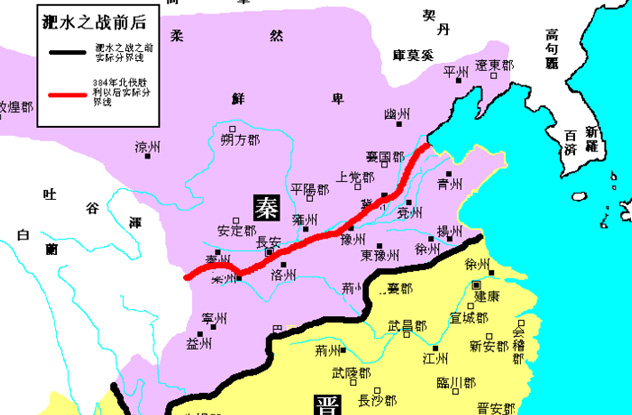
Widely considered one of the most important battles in Chinese history, the Battle of Fei River pitted the Eastern Jin dynasty of southern China against the barbarous inhabitants of the Former Qin dynasty of northern China. While the numbers might be exaggerated (a claim you could make against virtually every battle in human history), traditional historical sources say 800,000 soldiers marched from the north to face only 80,000 Eastern Jin Soldiers.
However, the Qin army was mostly made up of random conscripted soldiers, many of whom felt no loyalty toward their commanders or even outright hatred. In addition, they were poorly equipped and even more poorly trained. Fu Jian, the leader of the Qin dynasty, had conquered nearly all of the northern kingdoms of China, with those in the south squarely in his sights. So his men marched toward the lands of the Eastern Jin, successfully capturing many of the border cities.
In 382, Eastern Jin forces, led by the general Xie Xuan, decided to make their final stand at the Fei River, a waterway that is now dried up. The Eastern Jin forces were on one side of the river, and the Qin army was on the other. Xie Xuan sent word to his enemies, asking them to retreat slightly to the west so as to allow his forces to cross the river and commence the battle. When Fu Jin, the emperor of the Qin dynasty, agreed, many of his soldiers believed they had been defeated and panicked. Seizing this opportunity, Xie Xuan struck, killing nearly all of his enemies. By the end of the fighting, there was so much death that one account says: “The dead were so many that they were making a pillow for each other on the ground.” Shortly afterward, the Qin dynasty, devastated by the loss, plunged into civil war.
2Polish Infantry
Battle Of Wizna
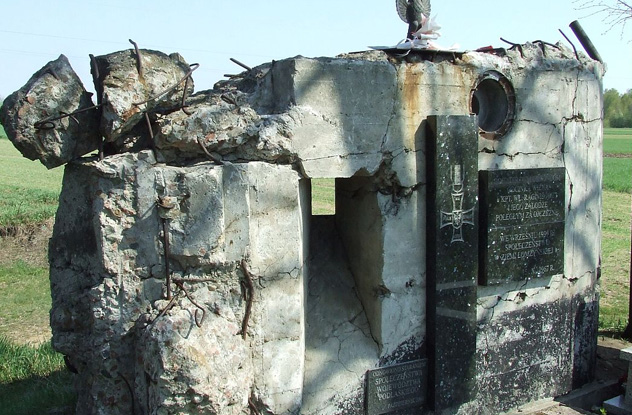
Often described as the Polish Thermopylae, the Battle of Wizna saw an extremely outnumbered Polish force defend the city of Wizna against the onslaught of the German army. Though this is commonly seen as the beginning of the German blitzkrieg, the invasion of Poland was conducted through more traditional military means. Nevertheless, the difference in strength was overwhelming: 700 Poles were in the city, facing off against 40,000 Germans. (In fact more recent historians have claimed there may have only been about 360 Poles in the city.)
The fighting broke out on September 7, 1939, and lasted for two and a half days. To boost morale, as the Poles had heard of the vast army which was bearing down on them, the commander of the Polish forces, a man named Wladyslaw Raginis, vowed to not leave any defended position alive. However, the Polish forces quickly found themselves out of ammo, with no hope of reinforcements. In addition, the German commander, Heinz Guderian, threatened to execute every one of the Polish POWs if they didn’t surrender. In the end, Raginis agreed, sending his troops out of the bunker. One of them, Seweryn Bieganski, recalled later: “The captain looked at me warmly and softly urged me to leave. When I was at the exit, I was hit on my back with strong gust, and I heard an explosion.”
While they were unsuccessful in keeping Wizna out of German hands, the defenders did allow Polish leadership and many other soldiers to escape to Western Europe, where they continued the fight against the Nazis.
1Korean Navy
Battle Of Myeongnyang

Originally an army commander, Yi Sun-Sin began his military career fighting the Manchu nomads who roamed Korea’s northern border. A short while later, he was made commander of the Cholla naval district and defeated the Japanese fleet in several battles, thanks in no small part to his kobukson, the famed “turtle ships” of the Joseon dynasty. Due to a plot by a Japanese double agent, Sun-Sin was arrested and tortured for refusing orders that he deemed to be too dangerous. (Which they were, as the double agent wished to destroy the Korean fleet.)
Spared the death penalty but demoted to a lowly rank, Sun-Sin bided his time until the Korean leadership called on him again. The Japanese had mounted another attack and seemed to have turned the tide. Thanks to the many defeats of the general who preceded him, Sun-Sin only had 12 ships left to defend the country with, and he decided to make a last stand in the Myeongnyang Strait, just off the southwest coast of Korea. Though sources differ, the vast agree that at least 133 Japanese ships met him there, determined to end the war once and for all.
Using his knowledge of the ocean around him, as well as the strength of his ships, Sun-Sin routed the Japanese, destroying 31 of their ships while losing none of his own. Part of the massive victory was because the Japanese tended to try and win naval battles in the same vein of the Romans when they faced off against the Carthaginians: They tried to board the enemy ships rather than ram them. This proved fruitless against the kobukson, and Korea was victorious.





